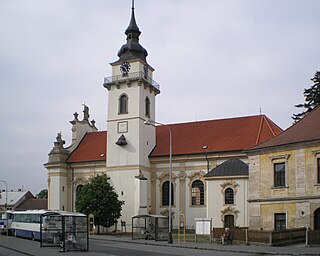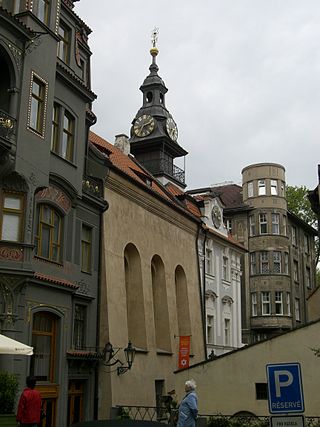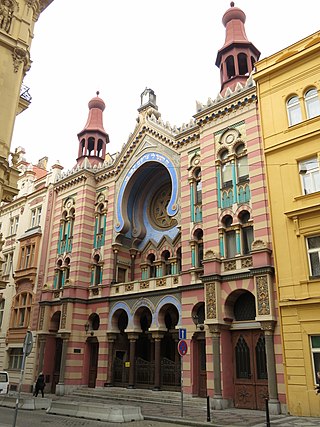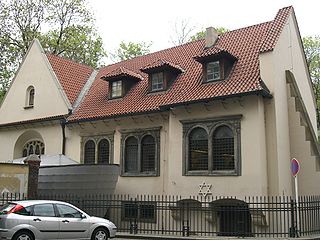
Boskovice is a town in Blansko District in the South Moravian Region of the Czech Republic. It has about 12,000 inhabitants. The area of the historic town centre, Jewish quarter, château complex and castle ruin is well preserved and is protected by law as an urban monument zone.

Břeclav is a town in the South Moravian Region of the Czech Republic. It has about 25,000 inhabitants.

Josefov is a town quarter and the smallest cadastral area of Prague, Czech Republic, formerly the Jewish ghetto of the town. It is surrounded by the Old Town. The quarter is often represented by the flag of Prague's Jewish community, a yellow Magen David on a red field.

Hořovice is a town in Beroun District in the Central Bohemian Region of the Czech Republic. It has about 7,800 inhabitants. The town is known for the Hořovice Castle.

Heřmanův Městec is a town in Chrudim District in the Pardubice Region of the Czech Republic. It has about 5,000 inhabitants. The historic town centre with the castle complex is well preserved and is protected by law as an urban monument zone.

The history of the Jews in Prague, the capital of today's Czech Republic, relates to one of Europe's oldest recorded and most well-known Jewish communities, first mentioned by the Sephardi-Jewish traveller Ibrahim ibn Yaqub in 965 CE. Since then, the community has existed continuously, despite various pogroms and expulsions, the Holocaust, and subsequent antisemitic persecution by the Czech Communist regime in the 20th century.

The High Synagogue, also called the Josefov Vysoká Synagogue, is a Jewish congregation and synagogue, located on Červená ulice, Prague, in the Czech Republic. Used as a synagogue from 1658 until World War II, the building is now part of the Jewish Museum of Prague.

Moorish Revival or Neo-Moorish is one of the exotic revival architectural styles that were adopted by architects of Europe and the Americas in the wake of Romanticist Orientalism. It reached the height of its popularity after the mid-19th century, part of a widening vocabulary of articulated decorative ornament drawn from historical sources beyond familiar classical and Gothic modes. Neo-Moorish architecture drew on elements from classic Moorish architecture and, as a result, from the wider Islamic architecture.

The Dolní Kounice Synagogue is a former Orthodox Jewish synagogue, located in Dolní Kounice in the South Moravian Region of the Czech Republic. The building was completed in 1655 and was used as a synagogue by the Ashkenazi congregation until 1939. The building has been used as a Jewish museum since 1994.

The Jubilee Synagogue, also known as the Jerusalem Synagogue, is an Orthodox Jewish synagogue, located on Jerusalem Street in the Nové Město district of Prague, in the Czech Republic. It is the largest synagogue in Prague.

Nová Cerekev is a market town in Pelhřimov District in the Vysočina Region of the Czech Republic. It has about 1,200 inhabitants.

The Spanish Synagogue is a former Reform Jewish synagogue, located in the area of the so-called Jewish Town, Prague, in the Czech Republic. The synagogue was completed in 1868 in the Moorish Revival style on the site of the presumably oldest synagogue, Old School. In 1955 the former synagogue was permanently repurposed as a Jewish museum and is administered by the Jewish Museum in Prague.

The Jewish Museum in Prague is a museum of Jewish heritage in the Czech Republic and one of the most visited museums in Prague. Its collection of Judaica is one of the largest in the world, about 40,000 objects, 100,000 books, and a copious archive of Czech Jewish community histories.

POLIN Museum of the History of Polish Jews is a museum on the site of the former Warsaw Ghetto. The Hebrew word Polin in the museum's English name means either "Poland" or "rest here" and relates to a legend about the arrival of the first Jews to Poland. Construction of the museum in designated land in Muranów, Warsaw's prewar Jewish quarter, began in 2009, following an international architectural competition won by Finnish architects Rainer Mahlamäki and Ilmari Lahdelma.

The Smíchov Synagogue is a former Reform Jewish congregation and synagogue, located at Stroupežnického 32, Smíchov, in Prague, in the Czech Republic. Completed in 1863, the former synagogue was remodelled in 1931 in the Functionalist style. After the World War II, the building was used for secular purposes because the Smíchov Jewish community ceased to exist in the Shoah. Since 1998, the building has been used as an archive of the Jewish Museum in Prague.

Czech Gothic architecture refers to the architectural period primarily of the Late Middle Ages in the area of the present-day Czech Republic.

The Pinkas Synagogue is a former Jewish congregation and synagogue, located at Široká 3, in the Jewish Town of Prague, in the Czech Republic. Completed in 1535, the synagogue the second oldest surviving synagogue in Prague and was completed in the Gothic style. Its origins date from the 15th century and are connected with the Horowitz family, a renowned Jewish family in Prague. Today, the synagogue is administered by the Jewish Museum in Prague and commemorates approximately 80,000 Czech Jewish victims of The Shoah.

Czech Renaissance architecture refers to the architectural period of the early modern era in Bohemia, Moravia and Czech Silesia, which then comprised the Crown of Bohemia and today constitute the Czech Republic. The Renaissance style flourished in the Czech lands from the late 15th century to the first half of the 17th century.

The Klausen Synagogue is a former Jewish synagogue located in Prague, in the Czech Republic.

The Ceremonial hall of the Prague Jewish Burial Society was built for the last service to the deceased members of the Prague Jewish Community. It is used as an exhibition space administered by the Jewish Museum in Prague. The building is an excellent example of Romanesque Revival architecture.






















